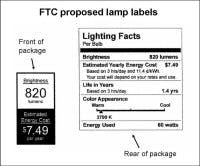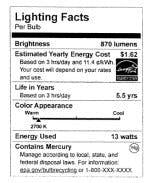The proposed amendments apply to common household (medium screw base) light bulbs, including general service incandescent bulbs and CFLs, and would also apply to medium screw base LED lamps.
The FTC published a press release in late October, and then a Notice of Proposed Rulemaking (NOPR) was published in the Federal Register on November 10 (download Notice, PDF, 660 KB).
Written comments must be received on or before December 28, 2009.
The proposed package labeling amendments create a two-panel labeling format: a front panel with brightness and energy cost information, and a Lighting Facts label with additional information on the side or rear panel (see Fig.1).
The two data points on the front of the package are those shown by focus groups to be most important to buyers when trying to compare products. The Lighting Facts approach is similar to the labels introduced by the DOE’s Solid State Lighting Quality Advocates program.
The labels also would require disclosures for bulbs containing mercury (see Fig. 2).







